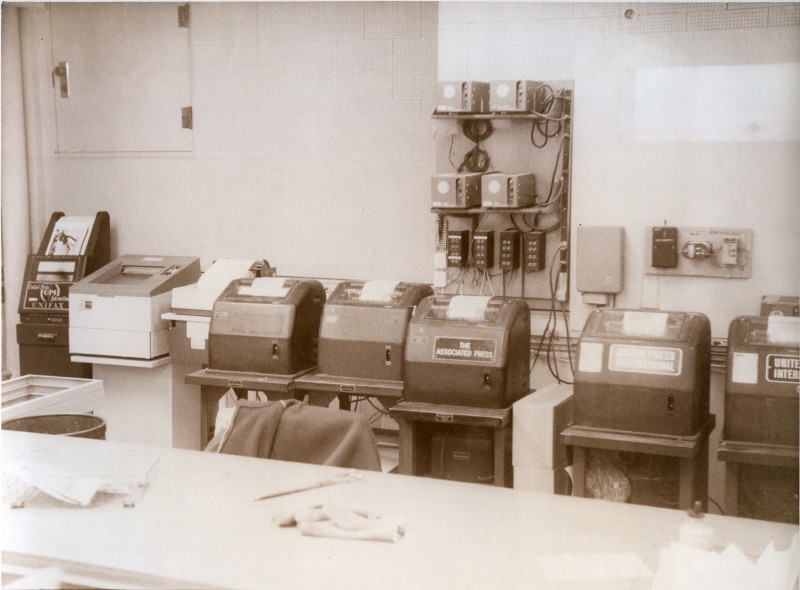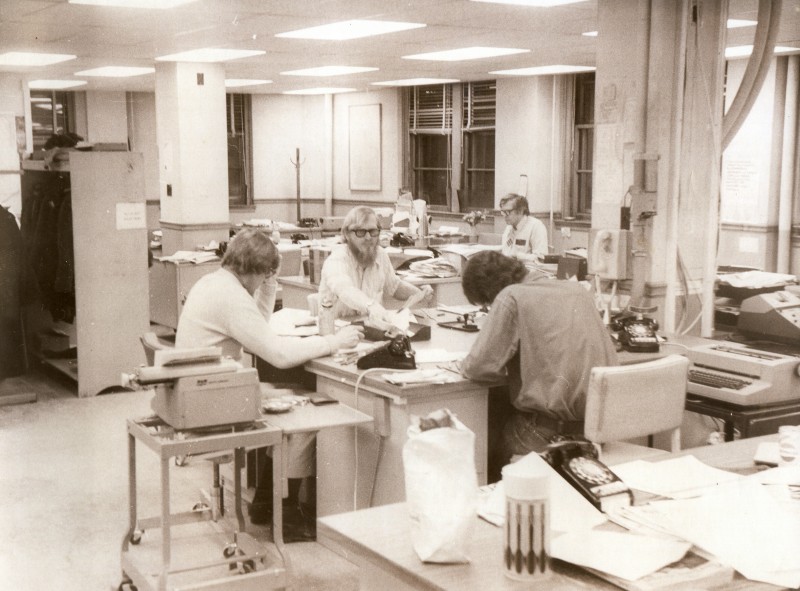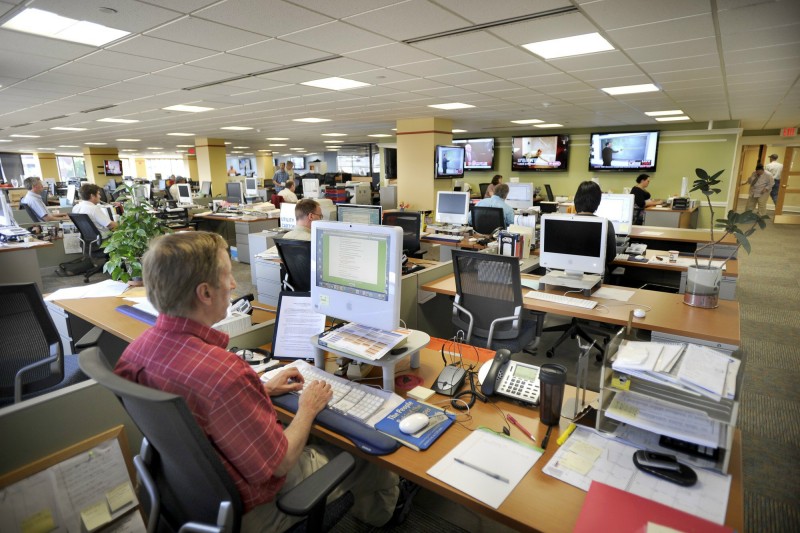The process of assembling and distributing the news – something that people can do today on their cellphones – was once so cumbersome and expensive that newspapers served as a gateways for news, particularly before the arrival of radio and television.
In 1927, the Portland Press Herald’s monopoly was so great that a throng of 2,000 people gathered around the newspaper’s Congress Street offices to watch a mechanical scoreboard display the progress of World Series games between the New York Yankees and the Pittsburgh Pirates.
At that time, the newspaper was a creature of the Industrial Revolution. Nineteenth-century inventions like the Linotype machine – a crazy Rube-Goldbergian device – enabled linotype operators to produce an entire line of type instead of individual words.
The use of Linotype machines lasted for nearly a century until they were replaced at the Press Herald in 1973 by a photographic process referred to as cold type.
By 1978, when the typewriters were replaced by a computerized electronic editing and production system, the Information Age had taken hold, reaching a critical mass in the early 1990s with the public’s adoption of the Internet.
And so technology – which at one time enabled the newspaper to become a powerful force in society – became a threat, eviscerating its monopoly on news and advertising and weakening its businesses model.
The public’s expectations for what it wants from today’s Press Herald has also changed, and the newspaper in turn has responded, moving away from its role as a single-source provider of raw information – eliminating stock tables, for example – and providing content on multiple platforms, including its website, pressherald.com. Also, the newspaper is now putting more emphasis on enterprise and investigative reporting.
Technological advances have transformed the way the Press Herald gathers and distributes news. Switching to digital photography in 2000 sped up processing time and allowed photographers to transmit photos from a crime scene or sporting event immediately. Photographers routinely shoot video, and some reporters are using iPhones to take video as well. Newsroom employees have begun aggressively using Facebook, Twitter and other forms of social media to distribute the news, and readers are using social media to access and share stories.
The Internet has also empowered readers, allowing them to easily interact with the newspaper staff, said Michael Socolow, who teaches the history of mass media at the University of Maine Department of Communication and Journalism.
“The public talks back,” he said.
Before computers, producing a newspaper was a messy, noisy and labor-intensive business. Reporters hammered out stories on manual typewriters, and editors marked up corrections and moved sentences and paragraphs by cutting and pasting. Photos from the bureaus were often shipped to the newspaper on a Greyhound bus.
Copy boys delivered the reporters’ marked-up stories to the composing room. The boys were later replaced by pneumatic tubes. After Linotype operators produced lines of metal type, other workers assembled the type and corrected any errors they found. Make-up men arranged the copy in page form. Galley proofs were made and sent to proofreaders. Workers then placed metal frames around the type pages and pounded them into place. Lead plates were cast and transported on a conveyor belt through a tunnel under Congress Street to the printing presses across the street.
More than 100 people worked in the composing room, plus more than a dozen worked in the engraving and platemaking operations, said Art Hight, 76, who worked as a compositor at the Press Herald from 1956 to 1999.
Now, the process is so automated that two people do that work at night. They print out the pages on paper so they can proofread them, and they also check the pages on a computer screen that shows exactly what the pages will look like when they come off the presses. Then they electronically send the pages to the printing plant in South Portland.
“They still need someone to press the buttons,” said Ben Goodridge, a pre-press operator who has been at the newspaper since 1997.
Despite the labor-intensive process of the pre-digital era, people worked quickly. If there was a car accident at 1 a.m., the story could be written and processed in time for the 2:45 a.m. city edition deadline, said Dennis Twomey, 73, a retired copy editor who worked at the newspaper from 1967 to 2010.
The reporters back then wrote about details of community life. They attended most municipal board meetings and reported about car accidents that today would be considered to be too minor to be newsworthy, he said.
Back then, the newspaper had a more intimate role in people’s lives, he said. “People felt the newspaper was part of their household.”
The apex of the newspaper industry in America was 1910, when the nation supported 2,200 daily newspapers. Today, there are just over 1,400. Many cities had multiple daily newspapers. Portland in 1882 had three daily papers and four Sunday papers.
The Press Herald’s circulation peaked at 76,200 in 1995. On Labor Day weekend that same year, the newspaper launched its first website. The Press Herald’s Sunday edition, the Maine Sunday Telegram, peaked in 1994 at 142,200 subscribers.
The Press Herald’s average daily circulation is now 46,071, and the Maine Sunday Telegram is around 76,000, according to a the most recent public data available.
Many former subscribers have migrated to the newspaper’s website, pressherald.com, which gets 50,000 to 63,000 unique visitors daily.
While a lot of people have nostalgic feelings about newspapers of old, much of the journalism was “absolutely horrible,” said Kelly McBride, a Poynter Institute faculty member who is studying how democracy will be affected as journalism shrinks.
In the 1940s and 1950s, when newspapers’ influence peaked, she said, power in society was concentrated in the hands of a few groups, and many groups, such as minority communities, were left out, she said.
She said newspapers did their best journalism in the 1980s and 1990s, when they were still highly profitable but were faced with declining readership. That decline was due in part to the changes in society, she said. Structures that helped tie communities together, such as bowling leagues and church congregations, were weakening, and local news was just not as important to people, McBride said.
Now, because advertisers have so many other choices, the newspaper business model has weakened to the point where she wonders if many cities in the future will be able support a daily newspaper. Several daily newspapers have cut back to three days a week, and others have announced plans to do the same, including the Patriot-News of Harrisburg, Penn., which won a Pulitzer Prize this year for its coverage of the Jerry Sandusky child molestation scandal.
“Now I see a fight for survival,” McBride said.
With basic information such as weather reports and school closing notices now widely available, newspapers still have the role of asking the tough questions, such as tracking how public money is spent or whether local police are respecting people’s civil rights, she said.
While groups have started websites that aim to do this kind journalism, she added, nobody has found an economic model to pay professional journalists to do high-quality work, she said.
“It takes a fair amount of skill and time and energy find out the answers to those questions,” she said.
At the same time, bloggers are now challenging the idea of journalism as a profession, said Socolow, of the University of Maine.
Newspapers like the Press Herald are faced with the duel task of finding new ways to make money while also affirming the role of professional journalism in society, he said.
“Its role now is to provide professionally vetted information, with elevated standards of accuracy,” he said. “It’s about trust. Newspapers haven’t done enough to monetize their credibility and trust.”
Staff Writer Tom Bell can be contacted at 791-6369 or at
tbell@pressherald.com
Send questions/comments to the editors.





Success. Please wait for the page to reload. If the page does not reload within 5 seconds, please refresh the page.
Enter your email and password to access comments.
Hi, to comment on stories you must . This profile is in addition to your subscription and website login.
Already have a commenting profile? .
Invalid username/password.
Please check your email to confirm and complete your registration.
Only subscribers are eligible to post comments. Please subscribe or login first for digital access. Here’s why.
Use the form below to reset your password. When you've submitted your account email, we will send an email with a reset code.